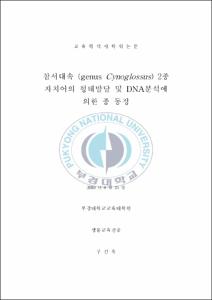참서대속 (genus Cynoglossus) 2종 자치어의 형태발달 및 DNA분석에 의한 종 동정
- Alternative Title
- Morphological development and molecular identification of two Cynoglossus spp. larvae
- Abstract
- Abstract
Cynoglossidae larvae were analyzed by morphological and molecular analyses based on samples collected from South Sea and Yellow Sea of Korea in 2008 and 2009.
Cynoglossus joyneri larvae was distinguished from C. abbreviatus, C. robustus and C. semilaevis by elongate dorsal fin rays (2 elongate dorsal fin rays in C. joyneri vs. 1 elongate dorsal fin ray in C. abbreviatus, C. robustus and C. semilaevis). It was distinguished from C. gracilis by dorsal and anal fin rays (114-115 dorsal and 85-89 anal fin rays in C. joyneri vs. 128-137 dorsal and 104-108 anal fin rays in C. gracilis). It was distinguished from Paraplagusia japonica by melanophores (no long line melanophores on the mediolateral body in C. joyneri vs. long line melanophores on the mediolateral body in P. japonica). According to the molecular analyses using mitochondr- ial DNA 16S rRNA, C. joyneri larvae were 99% identified to adult of C. joyneri by genetic distances were d=0.000-0.007, whereas were d=0.141-0.215 with the other Cynoglossidae species.
C. abbreviatus larvae was distinguished from C. gracilis, C. joyneri and P. japonica by elongate dorsal fin rays (1 elongate dorsal fin ray in C. abbreviatus vs. 2 elongate dorsal fin rays in C. gracilis, C. joyneri and P. japonica). When 4.1 mm specimen, it was distinguished from C. robustus by the yolk sacs (yolk sacs remains even after 3.7 mm in C. abbreviatus vs. yolk sacs absorbed completely before 3.7 mm in C. robustus), and the former was distinguished from C. semilaevis by spawning season and elongate dorsal fin ray development period (March-June, elongate dorsal fin ray with hatched larvae in C. abbreviatus vs. August-Octobor, elongate dorsal fin ray development at 5.0 mm in C. semilaevis). When 11.3 mm specimen, it was distinguished from C. semilaevis by dorsal and anal fin rays (133 dorsal and 105 anal fin rays in C. abbreviatus vs. 122-128 dorsal and 95-100 anal rays in C. semilaevis), and the former was distinguished from C. robustus by spawning season (March-June in C. abbreviatus vs. June-August in C. robustus). According to the molecular analyses using mitochondrial DNA 16S rRNA, C. abbreviatus larvae were 100% identified to C. abbreviatus sequences deposited in NCBI by genetic distances were d=0.000-0.002, whereas were d=0.069-0.209 with the other Cynoglossidae species.
- Issued Date
- 2010
- Awarded Date
- 2010. 8
- Type
- Dissertation
- Publisher
- 부경대학교
- Department
- 교육대학원 생물교육전공
- Advisor
- 김진구
- Table Of Contents
- 목차
요약 ⅱ
I. 서론 1
II. 재료 및 방법 4
1. 실험표본 4
2. 형태분석 8
3. 분자분석 8
가. DNA추출 8
나. 중합효소연쇄반응 10
다. 자료분석 11
III. 결과 12
1. Cynoglossus joyneri Günther 12
가. 형태분석 12
나. 분자분석 20
2. Cynoglossus abbreviatus (Gray) 24
가. 형태분석 24
나. 분자분석 25
IV. 고찰 28
1. Cynoglossus joyneri Günther 28
2. Cynoglossus abbreviatus (Gray) 30
V. 참고문헌 35
감사의 글 40
- Degree
- Master
- Files in This Item:
-
-
Download
 참서대속 (genus Cynoglossus) 2종 자치어의 형태발달 및 DNA분석에 의한 종 동정.pdf
기타 데이터 / 1.69 MB / Adobe PDF
참서대속 (genus Cynoglossus) 2종 자치어의 형태발달 및 DNA분석에 의한 종 동정.pdf
기타 데이터 / 1.69 MB / Adobe PDF
-
Items in Repository are protected by copyright, with all rights reserved, unless otherwise indicated.